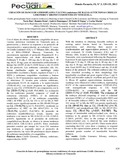Mostrar el registro sencillo del ítem
Creación de banco de germoplasma vacuno (embriones) de razas Autóctonas criollo limonero y siboney existentes en Venezuela
| dc.rights.license | http://creativecommons.org/licenses/by-nc-sa/3.0/ve/ | |
| dc.contributor.author | Roa A., Noris | |
| dc.contributor.author | Denis, Ramón | |
| dc.contributor.author | Domínguez, Andrés | |
| dc.contributor.author | D'Enjoy, D'Endel | |
| dc.contributor.author | Marín, Carlos | |
| dc.date.accessioned | 2013-10-25T13:46:05Z | |
| dc.date.available | 2013-10-25T13:46:05Z | |
| dc.date.issued | 2013-10-25T13:46:05Z | |
| dc.identifier.issn | 1856-111X | |
| dc.identifier.uri | http://www.saber.ula.ve/handle/123456789/37696 | |
| dc.description.abstract | Con el objeto de obtener embriones congelables de razas vacunas autóctonas existentes en Venezuela para su preservación, y observar su respuesta a un protocolo de sincronización y superovulación, se evaluaron 51 vacas, 34 Criollo Limonero (CrL) y 17 Siboney (Sib), ubicadas en el INIA–CENIAP Maracay, Venezuela. Se sincronizaron siguiendo el protocolo Pregnaheat-E ® y fueron superovuladas con dosis descendentes de Folltropin V ® (día 5: 100 mg; día 6: 60 mg; día 7: 40 mg; día 8: 20 mg), para ser inseminadas artificialmente a tiempo fijo (IATF) el día 9 (18:00 horas) y día 10 (6:00 h) del protocolo. Los embriones colectados (día 16), fueron clasificados según su morfología como transferibles: excelentes y buenos, regulares (Clase 1 y 2; IETS) y embriones congelables: excelentes y buenos (Clase 1). De 85 tratamientos superovulatorios aplicados, se obtuvieron 53 lavados para colectar embriones, representando 62,4% de respuesta a la superovulación (53/85=62,4%); con mayor respuesta no significativa, para la raza CrL (33/50=66,0%) en comparación con la Sib (20/35=57,1%) (χ²=0,69; P=0,4068). La evaluación de los embriones permitió comparar: n° total de estructuras colectadas (NTEC), n° de embriones transferibles (NET) y n° de embriones congelables (NEC). El NTEC en CrL fue 154 vs 147 en Sib, el NET resultó mayor significativamente en Sib (89=60,5%) que en CrL (74=48,1%) (χ²=4,73; P=0,0297); resultando no significativo el NEC en Sib (85=57,8%) vs CrL (70=45,5%) (χ²=0,07; P=0,7887). El promedio de embriones transferibles/vaca lavada, muestra una tendencia a ser mayor en Sib (4,5±1,0) vs CrL (2,2±0,4; p>0,05). Igualmente en el promedio de embriones congelables/vaca lavada, se observa la misma tendencia (Sib=4,3±0,8; CrL=2,1±0,4; p>0,05). Estos resultados permiten concluir que aunque las vacas CrL muestran una tendencia a responder mejor al protocolo de superovulación, las vacas Sib presentaron mayor número de embriones transferibles y/o congelables. | es_VE |
| dc.language.iso | es | es_VE |
| dc.rights | info:eu-repo/semantics/openAccess | |
| dc.subject | Criollo Limonero | es_VE |
| dc.subject | Siboney | es_VE |
| dc.subject | Embriones | es_VE |
| dc.subject | Superovulación | es_VE |
| dc.subject | IATF | es_VE |
| dc.title | Creación de banco de germoplasma vacuno (embriones) de razas Autóctonas criollo limonero y siboney existentes en Venezuela | es_VE |
| dc.type | info:eu-repo/semantics/article | |
| dc.description.abstract1 | With the intention to obtaining freezable embryos in existing native bovine breed in Venezuela to preservation, and observing their answer to synchronization and superovulation protocol, 51 cows were evaluated, 34 Criollo Limonero (CrL) and 17 Siboney (Sib), located in the INIA-CENIAP Maracay, Venezuela, were synchronized following the Pregnaheat-E protocol ® and superovulated with descendent doses of Folltropin V ® (day 5: 100 mg; day 6: 60 mg; day 7: 40 mg; day 8: 20 mg), and then artificially inseminations in time fixed (IATF) day 9 (18:00 hours) and day 10 (6:00 hours) of the protocol. The collected embryos (day 16), were classified according to their morphology like transferable: excellent and good, regular (Class 1 and 2; IETS) and freezable embryos: excellent and good (Class 1). From 85 applied superovulations treatments, 53 washings were obtained to collect embryos, representing 62.4% of the superovulation response (53/85=62.4%); with nonsignificant response, to CrL breed (33/50=66.0%) in comparison with the Sib (20/35=57.1%) (χ² =0.69; P=0.4068). The evaluation of the embryos allowed comparing: n° total of collected structures (NTEC), n° of embryos transferable (NET) and n° of freezable embryos (NEC). The NTEC in CrL was 154 versus 147 in Sib, the NET was greater significantly in Sib (89=60.5%) than in CrL (74=48.1%) (χ²=4.73; P=0.0297); and nonsignificant NEC in Sib (85=57.8%) versus CrL (70=45.5%) (χ²=0.07; P=0.7887). The average of transferable embryos/washed cow, shows a tendency to be greater in Sib (4.5±1.0) versus CrL (2.2±0.4; p>0.05). Also, in the average of freezable embryos/washed cow, is observed the same tendency (Sib=4.3±0.8; CrL=2.1±0.4; p>0.05). These results allow concluding that CrL cows show a tendency to respond better to the superovulation protocol, the Sib cows have presented greater number of transferable freezable embryos. | es_VE |
| dc.description.colacion | 129-135 | es_VE |
| dc.description.email | nroa@inia.gob.ve | es_VE |
| dc.identifier.depositolegal | 200502MEI822 | |
| dc.subject.facultad | Núcleo Rafael Rangel (NURR) | es_VE |
| dc.subject.keywords | Embryos | es_VE |
| dc.subject.keywords | Superovulation | es_VE |
| dc.subject.publicacionelectronica | Revista Mundo Pecuario | |
| dc.subject.seccion | Revista Mundo Pecuario: Artículos | es_VE |
| dc.subject.tipo | Revistas | es_VE |
| dc.type.media | Texto | es_VE |
Ficheros en el ítem
Este ítem aparece en la(s) siguiente(s) colección(ones)
-
Mundo Pecuario - Vol. 009 - Nº 3
Septiembre - Diciembre 2013


